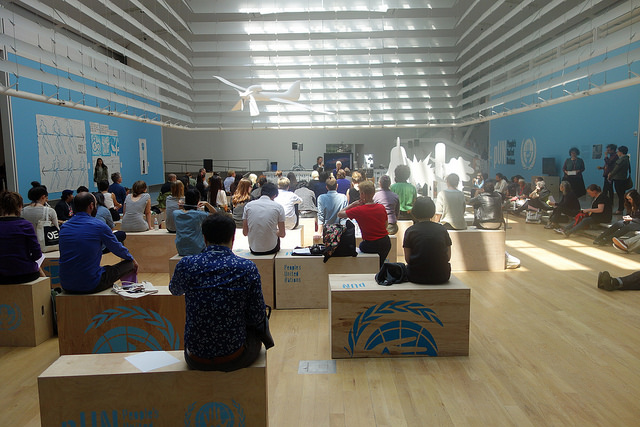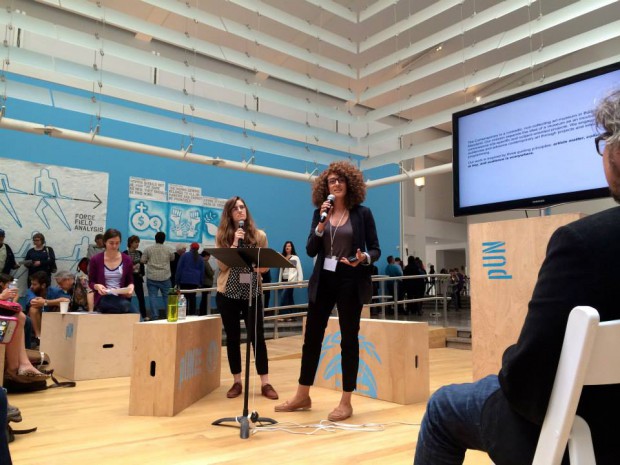Depending on the day and the time last weekend, the Queens Museum was packed. People were there for Open Engagement, a conference with the goal of expanding the dialogue around socially engaged art-making. Launched in Regina, Saskatchewan in 2007, then held in Portland since 2010, this year sees the conference’s east coast debut.
Overall, the conference brought in a mix of art-makers we were unaccustomed to seeing. (We’re used to the art fair and biennial circuit, which is made up almost exclusively of commercially successful artists, dealers, and curators.) Here, we met up with activists, artists, designers, and civil servants. We saw a lot of wrap dresses and beards.
We’re not wearing wraps just yet, but we like what we saw and who we met. In addition to the hefty number of local participants, we also met seemingly countless people who flew in specifically for the conference. In one presentation we attended, only a quarter of attendees raised their hand when asked if they were from New York.
That small anecdote sparked a few questions: Are socially engaged art practices growing with the increasing need for art to demonstrate a public good for funding? Are artists outside of financial centers affected more?
The three-day conference didn’t provide answers to that, but we were introduced to hundreds of artists, none of whom were making art for people’s living rooms. Unlike most other artist talks, presenters focused on whether their projects were successful or not. And on a base level every project required social interaction and thought. That alone makes Open Engagement an essential gathering for any art professional.
We attended the conference Saturday and Sunday. Sunday was the busiest day we attended, so we’ll start there. All commentary below by Corinna Kirsch.
Sunday, May 18, 2014
Lunchtime Conversation Series, Sara Reisman, Percent for Art, “Public Art as Mirror”
Sara Reisman began this workshop session with a tough question: “Does an artwork need to be a reflection of a community?” Needless to say, the 21 of us (19 women and 3 men) didn’t have all the answers to this ethical quandary.
All around, this was one of the better sessions, thanks to the sheer willingness of the participants—many who’re actively engaged in public art, both as artists and bureaucrats—to share their problems with each other. In this sense, the panel proved that OE is definitely not CAA; it’s more personal experience, less reified history.
One participant mentioned working on a public art commission project, only to have the jurors question the merits of choosing an African-American artist for a predominantly white neighborhood. “How can they represent us?” one white panelist asked. Other fellow workshoppers had their own similar stories.
The question of representation has ended up becoming more than a question of ethics; as Reisman mentioned, there’s been a turn in public art commissions from monuments to site-specific work, and now to social practice. Public art programs are slowly, but surely picking up on this new reality. When New York’s new Cultural Commissioner Tom Finkelpearl asked Reisman what needs to change about the Percent for Art program, she flat-out told him, “We need to make social practice an option.”
“This is amazing!” whispered the woman sitting next to me. Agreed.
Parallel Programming, Edgar Arceneaux and Kevin Krapf, “Live/Work: Civic Life and Socially Engaged Art”
My takeaway from this talk? The United States government does not know how to run an art program.
Edgar Arceneaux was asked to make an art project to revitalize community development in the island of Sao Tome, off the coast of Gabon. This State Department-funded project was initiated in part by Kevin Krapf, an artist who also serves as the U.S. Embassy Cultural Attache to Sao Tome and Gabon.“Kevin thought that cultural diplomacy would best be served with social practice,” Arcenaux recalled during the talk. (We heard a bit from Kevin Krapf during the talk, but only via Arcenaux’s speakerphone.)
In 2013, Arceneaux developed “Three Million Years,” a project to redesign a city library and market and create a garden monument, all the while utilizing the skills of the local inhabitants.
Though the project had good intentions, and Arceneaux has plenty of experience combining art with neighborhood redevelopment as executive director of the Watts House Project in Los Angeles, there were some notable bureaucratic failures. Arceneaux spent a combined three weeks in Gabon last year, after which the locals living in Angolares were expected to continue the project. The library renovation has been completed, but the garden monument and the marketplace are still up in the air.
As for the U.S. government’s involvement with “Three Million Years,” theirs seems to be one of hands-off libertarianism.
“How this will continue and the U.S. government will pursue [it],” Kevin Krapf mentioned over the phone, “is based on individual effort.” Arceneaux planted the seed; it’s up to the residents of Sao Tome to complete the projects.
“Maybe in December 2014?” Arceneaux asked aloud, referring to the proposed completion date of the marketplace.
Open Platform, 10-minute-long sessions
Jay Erker, “Invitation to Collaborate: Art Work” https://www.facebook.com/events/586152518092412/
Artist Jay Erker works a full-time job as a paralegal. Work gets boring, thus Erker’s creation of a Facebook event page where anyone can ask her to make art while at work. The ones Erker highlighted were definitely standouts—like “Copy/Stamp,” a work based on the instruction to make a Karl Marx portrait from items lying around the office, and the “Infinity Waggle,” a dance Erker performed with her coworkers—though looking at the event page, there’s some pretty cliche instructions, too.
Cubicles deserve their own level of hell. Piero Passacantando, artist and sometimes corporate office hack, feels the same way. In his exhibition My Nerva, he wonders if there’s any way to escape from the certain fate of cubicle doom—maybe its design can be improved? Some of the results weren’t amazing. During a brainstorming session, the most popular response was to make cubicle space vertical (thus stacking the cubes) and to produce cubicles in brighter colors. Passacantando had an adequate idea going for him, but overall, this project goes to show that popular opinion doesn’t always command the best results.
Aliya Bonar, “Power Suits”
Aliya Bonar gave the most honest talk I heard all weekend. For the last few years, Bonar’s been sewing her own quirky brand of “Power Suits” for anyone who wants to showcase their “most powerful self.” In one instance, she spent a week workshopping with a Girl Scout troupe on crafting their own empowering fashions. Despite what you might read from the work’s mission, Bonar admitted she doesn’t want it to come across as a “feel-good pat on the back.” But, hey, after doing this for a couple years, Bonar’s had some misgivings.
“Actually, I realized it’s just a project about me,” she said, as I quickly scribbled down “THANK GOD REAL TALK” in my notes. “I’m just being authentic and true to myself,” Bonar added, because if she gets this feeling from inspiring outerwear, heck, someone else might, too.
I bet Bonar’s not the only one feeling that way at Open Engagement. If you’re thinking about how art can help out others all the time, without spending just enough time about your own practice, you might find yourself at a dead-end.
Thank you, Aliya.
Deana Haggag and Ginevra Shay, The Contemporary, “Audience Is Everywhere”
What’s a museum without a home? The Contemporary. Deana Haggag came on board with The Contemporary, Baltimore’s only contemporary art museum, just over a year ago. At the time, Haggag and Shay mentioned, the museum was in shambles. The Contemporary had lost its building and the board had to consider dissolving the museum entirely. They decided to continue on as a “nomadic” museum, without a home. (This was how the museum was originally intended, when it was formed in 1989.) Right now, the museum is in the middle of figuring out its purpose in Baltimore; they’re open to suggestions, asking other organizations, local artists, and regular museum-goers what they want out of a museum. Inadvertently, at least one social project has been birthed from the museum’s ashes. The Contemporary has instituted a local sharing program to loan out equipment (like lighting) leftover from their physical space.





Comments on this entry are closed.